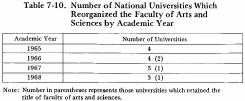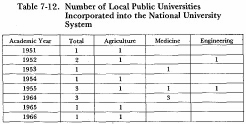- 現在位置
- トップ > 白書・統計・出版物 > 白書 > JAPAN'S MODERN EDUCATIONAL SYSTEM > (4)The Development of the National Universities
(4)The Development of the National Universities
There were several improvements in the national university system during this period
In order to establish, within each prefecture, one national university with a faculty or department which would provide certain special courses related to teacher training as well as a basic general education for all students, a number of institutions were started either from the old normal schools or as branch schools responsible for two-year courses. In the years starting from 1953, steady progress was made in the unification of these branch schools, considering the demand and supply of teachers. The development of the national teacher training faculties was particularly notable from 1959.
Fourteen of the national universities recognized at the beginning of the new system had faculties of arts and sciences which were to provide both a general education and a teacher training course in addition to the regular courses of these faculties. However as most of these arts and sciences faculties had been created from higher schools (koto gakko) of the old educational system and lacked sufficient teaching staff, facilities and equipment for university level education, and most importantly, a clear conception of the aims of these faculties, few were able to fulfill their responsibility adequately. Since 1965 the arts and sciences faculties of the national universitie5have been divided or reorganized so as to reflect the needs of each individual university (See Table 7-10.).As early as 1963, by a revision of the National School Establishment Law, which was promulgated on March 31, 1963,and put in force on April 1 of that year, it was determine([that certain national universities which had a number of faculties could be designated by ministry of education regulations as those that should establish a college of general education (kyoyobu), which as a separate unit within the university, was to provide the general education which hereto-fore mostly had been part of the arts and sciences faculty. This reform, accomplished over a six-year period (See Table 7-11.), helped the national universities to accommodate a larger number of students.
A second type of structural change resulted from the transformation of a number of local public universities into faculties of the nearest national university, primarily to relieve them of financial difficulties. A total of thirteen new faculties were thus affiliated by 1966, including six faculties of agriculture, five faculties of medicine, and two faculties of engineering (See Table 7-12.).
Table 7-10. Number of National Universities Which Reorganized the Faculty of Arts and Sciences by Academic Year

Table 7-11. Number of National Universities Which Established Colleges of General Education by Academic Year

Table 7-12. Number of Local Public Universities Incorporated into the National University System

Budgetary reforms, based on the recommendations of the Central Council for Education's 1963 report fitted "On the Improvement of University Education," were included in the Law concerning Special Accounts for National Schools, which was promulgated on April 3, 1964, and put in force on that day. This legislation enabled national universities to supplement their regular budgetary appropriation with revenue obtained from the sale of property or from loans. Increased sources of revenue, in turn, made it possible for the universities to expand and improve their facilities, in particular the number of university hospitals, and to accommodate a larger number of students.
お問合せ先
(C)COPYRIGHT Ministry of Education, Culture, Sports, Science and Technology
-- 登録:平成21年以前 --